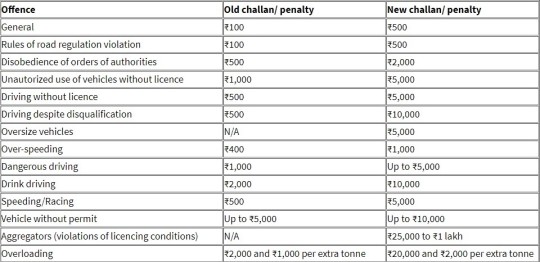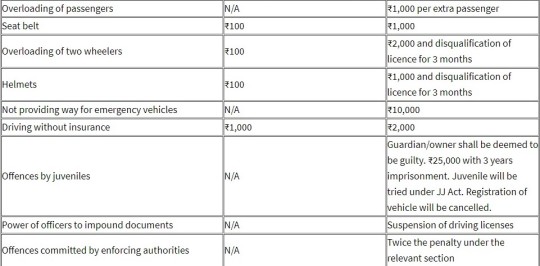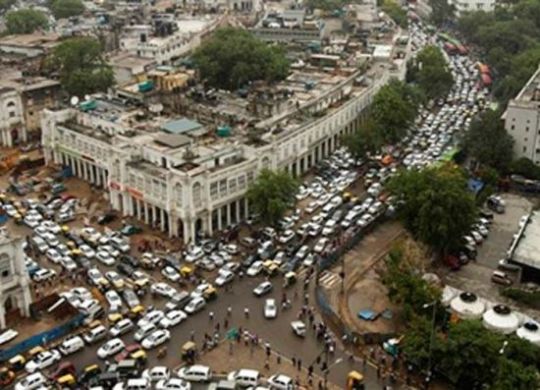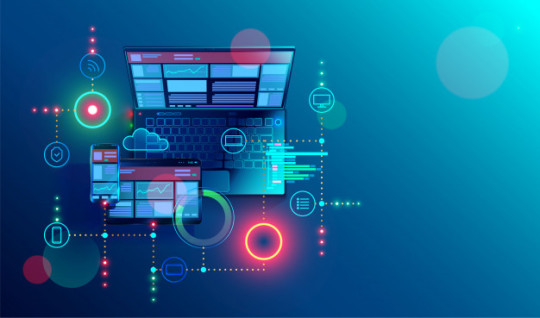Text
New Traffic Rules-Developing India
1) Driving In India

Driving in India is governed by various legal powers and in some cases is subject to the passing of a driving test. The Ministry of Road Transport and Highways, a branch of the Government of India, is the apex body for formulation and administration of the rules, regulations and laws relating to road transport, national highways and transport research, in order to increase the mobility and efficiency of the road transport system in India. Unlike most countries in the world, Indian traffic drives on the left.
2) Driving licence
Driving licences may be obtained by any citizen of age 18 or above, subject to certain conditions. Initially, a provisional licence is issued, which restricts the holder to driving whilst accompanied by a driver who has held a full licence in the category of vehicle they are supervising the learner driver. The provisional licence may be exchanged for a full licence after the holder has passed the driving test. On reaching the age of 50, drivers may apply to have their licences renewed with a medical/fitness certificate. Many foreign driving licences permit one to drive in India for a period of one year.
3) Road Death Rate In India,2015

In 2015,India road crashes kill 146,133 people in 2015. More than 140,000 people were killed on India's roads last year, according to figures released by the government. The total number of fatalities represent an increase of 4.6% on the previous year.
The three highest total number of fatalities were reported in Uttar Pradesh, Maharashtra and Tamil Nadu, and together they accounted for about 33% of total Indian traffic fatalities in 2015.
These cities accounted for 18.7 percent of the total road accidents in the country during 2015. Chennai leads the pack with total of 7486 accidents followed by Delhi and Bengaluru. The maximum deaths is recorded in Delhi followed by Chennai.
4) Road Death Rate in 2017

In 2017, a whopping 1.47 lakh people died in road deaths in India, which is equivalent to the entire pollution of Shillong, the capital of Meghalaya. Every year, over a lakh die as a result of road crashes and the proportion of those who get injured is nearly three to four times higher.
According to a report of the Central Ministry of Road Transport and Highways, Chennai saw the most number of road accidents, followed by Delhi, Indore , Bhopal and Jabalpur. For a second consecutive year, Mumbai reported the sixth-highest number of road accidents among Indian cities in 2017, official data revealed.
5) Updated Traffic Rules In India


6) Major Problems face By Roadways In India

Most of the Indian roads are unsurfaced (42.65%) and are not suitable for use of vehicular traffic. The poor maintenance of the roads aggravate the problem especially in the rainy season.
According to one estimate there is about per year loss of Rs. 200 crores on the wear and tear of the vehicles due to poor quality of roads. Even the National Highways suffer from the deficiencies of inadequate capacity, weak pavement, poor riding quality, distressed bridges, unabridged level crossings, congested cities (lack of by-pass roads), lack of wayside amenities and safety measures.
One major problem on the Indian roads is the mixing of traffic. Same road is used by high speed cars, trucks, two wheeler, tractors, animal driven carts, cyclists and even by animals. Even highways are not free from this malady. This increases traffic time, congestion and pollution and road accidents.
0 notes
Text
India A Developing Country
1) Difference Between Developed Countries And Developing Countries

Exceeding even the $12,000 GDP does not automatically qualify a country as being developed. Developed countries share several other characteristics:
They are highly industrialized.
Their birth and death rates are stable. They do not have excessively high birth rates because, thanks to quality medical care and high living standards, infant mortality rates are low. Families do not feel the need to have high numbers of children with the expectation that some will not survive. No developed country has an infant mortality rate higher than 10 per 1,000 live births. In terms of life expectancy, all developed countries boast numbers greater than 70 years; many average 80.
They have more women working, particularly in high-ranking executive positions. These career-oriented women frequently choose to have smaller families or eschew having children altogether.
They use a disproportionate amount of the world's resources, such as oil. In developed countries, more people drive cars, fly on airplanes, and power their homes with electricity and gas. Inhabitants of developing countries often do not have access to technologies that require the use of these resources.
They have higher levels of debt. Nations with developing economies cannot obtain the kind of seemingly bottomless financing that more developed nations can.
2) Low Per Capita Income (PCI)
According to the International Monetary Fund’s Report, in 2017, India’s PCI was $ 1983 and was ranked 140 out of 188 countries.
Further, according to the World Bank’s Report, in 2017, India’s PCI was $ 1940 and was ranked 138 out of 184 countries.
Therefore, we can conclude that the per capita income of an Indian resident is lower than most countries in the world.
3) Occupational Pattern – Primary Producing
One of the fundamental characteristics of India as a developing economy is that it is majorly primary producing. What this means is that a majority of the population is engaged in agriculture (around 52 percent).
However, in 2011-12, the contribution of agriculture to the national income was only 13.9 percent. This disparity is slowing India’s progress.
The reason behind this difference is that agriculture is a low income earning sector. Also, productivity per person engaged in agriculture is very low.
4) Population Pressure

Try to read this number: 1,362,099,836.It is 1.36 billion – the population of India as on January 17, 2019, 21:30 hours. We are the second most populated country in the world and our population is equivalent to around 17.74% of the total world population.In India, the high levels of illiteracy lead to a high level of birth rates. Further, improvement in medical facilities has increased the average life of an Indian citizen and led to a decline in the death rates too.
5) Industrial Growth
In India there are no such uniformity during the plan periods as far as industrial growth is concerned. Indian industries during the Third Five Year Plan observed a decent growth of about 8%), but thereafter industrial stagnancy took place. In 1976-77, the growth was abnormally high, but it decreased steadily during 1979 80. Again, it rose up during 80’s, According to Economic Survey, the average] annual industrial growth rate in India which was 5.6% in First Fiver Year Plan had increased to 8.6% during The Tenth Fiver Year Plan.
6) Chronic Unemployment and Under-Employment in India
Due to the deficiency of capital in India, it is difficult to engage the entire population in gainful employment.Therefore, a cheap labor force is available in abundance. As a result, there is chronic unemployment and under-employment in our country.
7) Inequality in Wealth/Asset Distribution
Unequal asset distribution is the primary cause of inequality in income distribution in rural areas.This inequality also highlights the fact that the resource base of 50 percent of households in India is weak.It is so weak that it can barely provide them with anything above the subsistence level of income.
8) Low-levels of Technology
India is a country of eclectic mixes. One one side, a company uses one of the most modern technologies while another company from the same industry uses the most primitive one.Unfortunately, according to modern scientific standards, the majority of products are made with the help of inferior technologies.If you take a simple look at the productivity of a developed and underdeveloped nation, then the developed nation has better productivity since it uses superior technologies.
0 notes
Text
Fit India
1)Fitness
Physical fitness is a state of health and well-being and, more specifically, the ability to perform aspects of sports, occupations and daily activities. Physical fitness is generally achieved through proper nutrition, moderate-vigorous physical exercise, and sufficient rest. The Physical Activity Guidelines for Americans were created by the Office of Disease Prevention and Health Promotion. This publication recommends that all adults should avoid inactivity to promote good health mentally and physically

2) Fitness In India
Despite the mushrooming of gyms and fitness centers as well as the growing popularity of fitness apps and virtual gyms, most Indians do not find time to exercise. In a pan-India study conducted by Gympik, India’s largest fitness discovery platform, 53% of the respondents said that they lack the discipline to stay fit. Bengaluru tops this index with a Fitness Health Score (FHS) of 5.5, while Delhi (4.7) comes second and Mumbai (4.5) third, followed by Hyderabad (4.3).
Gympik conducted the market research - Weighing up fitness–in Delhi, Bengaluru, Mumbai and Hyderabad to find out the current fitness trends and habits among-st Indians. Based on the responses of 1.06 million people, mainly in the age group of 20-35 years, Gympik study found that 52% do not find time to exercise, while 36% lack the motivation to join a fitness centre. In fact, 14% claim to be absolutely clueless about where to begin their fitness journey from. Commenting on the research, Amaresh Ojha, Founder and CEO, Gympik, said, “In India, the top fitness players barely constitute 15% of the market share as compared to that of Japan and Singapore where 40% market share is covered by the top five players. There’s massive scope for consolidation in the organised fitness sector in India.”

3) Basic Workout
You want to get fit. But you don't want to join a health club -- it's too expensive, there's no gym convenient to you, or maybe you're just the independent type. Or perhaps you're already a gym member, but your schedule has been too manic for you to get away.
That leaves working out at home. But can you really get a great workout without leaving the house?
Absolutely, says Kevin Steele, PhD, exercise physiologist and vice president of 24 Hour Fitness Centers.
"In today's world, the reality of it is people don't have time to go to a facility every day anyway," he says. "And consistency is key."
Believe it or not, Steele says, at 24 Hour Fitness, they encourage folks to exercise at home as much as at the gym. This way, they are more apt to adopt fitness as a lifestyle. "The key thing is that you do something, somewhere, sometime," he says.
Steele and other fitness experts say it doesn't take much effort or money to design an effective workout program at home. Things like fit balls, dumbbells, exercise bands or tubing, and push-up bars are an inexpensive way to create a routine that works all the major muscle groups.
4) Prime Minister Narendra Modi launches 'Fit India Movement'
"Fitness is zero percent investment with infinite returns,"
The campaign is aimed at encouraging people to include physical activity and sports in their everyday lives.
A committee, headed by Sports Minister Kiren Fijju and comprising government officials, members of Indian Olympic Association(IOA), national sports federations, private bodies and fitness promoters, has been formed to take the movement forward.

5) Issues In India Because Of Fitness.
“Fitness has always been an integral part of our culture. But there is in difference towards fitness issues now. A few decades back, a normal person would walk 8-10 km in a day, do cycling or run.
“But with technology,physical activity has reduced.We walk less now and the same technology tells us that we are not walking enough,”he added
The 28-member government committee features secretaries of Sports, secondary Education, Ayush and Youth Affairs, among others.
Modi said the younger generation grappling with lifestyles diseases is a worrying trend.
“There is surge in diabetes and hypertension cases and other lifestyle diseases.We hear sometimes a 12 or 15-year-old is suffering from diabetes or a 30-year-old has had a heart attack. It is a worrying trend but I still find positives from it as I am a positive person. These are lifestyles disorders and can be fixed with change in lifestyles.
0 notes
Text
Internet Usage
Internet usage is the measurement (expressed in bytes, kilobytes, megabytes or gigabytes) of the amount of data flowing through your computer,mobile and the Internet network for a defined period. These data are transferred in both directions: from the Internet network to your computer (download), and from your computer to the Internet network (upload).
Whether it’s surfing the Web, sending emails, online games, various downloads, or using network gaming consoles, any activity on the Internet generates usage.

2) How Internet Helps Human?
The Internet has left a huge impact on our life. Since the internet was founded, it has brought information and knowledge on our fingertips. Internet has brought positivity in our life and has made it simple and easy. The Internet has left a huge impact in our daily life. Earlier we used to go to libraries in search of information on something but now we get that information in just a few clicks. The internet provides us with useful data, information and knowledge that is useful for social, personal and economic development. It is up to us to utilize our time on the internet in a useful and productive way.
There are many uses of the internet. The most important use is that you can get information and education from the internet. It provides us with various sites . It helps people learn various things and people get knowledge which they implement in their daily life.
3) Socially Usage Of Internet

It helps people connect with each other socially. It helps us to talk to people that are from far off places like in different state or foreign country. There are various apps that help us to share messages, photos and videos with different people that are living near or far off places. The apps like Whatsapp, Facebook, Twitter, Instagram, etc helps people share photos, videos and messages. There is another feature of internet called video calling. This is a very useful feature of internet. Everyone should know that use of internet technology in our daily life.
Internet has been a resourceful thing for students. They grab a huge amount of information about many things which help them increase their knowledge. It is the best platform where students can increase their knowledge and skills and implement those in their daily life. In the same way that an importance of education, teachers also increase their knowledge and skills and share them with students also.
4) Internet Improve Business

Internet is also a very good platform to promote our business. Our products can be sold by using various e-Commerce solutions on the Internet. Use of internet technology is growing fast in the world. We can now see new services and various business starting online every day due to the booming of E-commerce, internet technology and web design which is creating new job opportunities.
Internet is a huge Platform for buying and selling products. We can buy various types of goods and services from the internet. We can buy clothes, electronic gadgets, Hair products, health products etc. from the internet in just a few clicks. One of the major benefits of buying goods online is that we get a huge amount of discounts. Another benefit is that the good bought is delivered to our doorstep in just a few clicks.
5) Internet User In Earlier 2015
In 2015, the International Telecommunication Union estimated about 3.2 billion people, or almost half of the world's population, would be online by the end of the year. Of them, about 2 billion would be from developing countries, including 89 million from least developed countries.
6) In 2019
There are 4.39 billion internet users in 2019, an increase of 366 million (9 percent) versus January 2018. There are 3.48 billion social media users in 2019, with the worldwide total growing by 288 million (9 percent) since this time last year.
0 notes
Photo

1) Robert Downey Jr.
$66 million

2) Akshay Kumar
$65 million

3) Jackie Chan
$58 million

4) Bradley Cooper
$57 million

5)Adam Sandler
$57 million
0 notes
Link
If you are passionate, go getter, want to see happy faces , round-the-clock energy. Eduvogue is the place for you. We are always looking for people who value Subordination of Interest. At Eduvogue, you will work with motivated, skilled and optimistic people who will support you for your out of the box thinking. We believe in simple Principle : When you enjoy what you do, work becomes Play!
0 notes
Quote
The harder you work for something, the greater you’ll feel when you achieve it.

0 notes
Photo

1) Nile River
Length: 6,650 km
2nd source: Blue Nile
Mouth: Mediterranean Sea
Sources: Blue Nile, White Nile
Countries: Egypt, Sudan

2) Amazon River
Length: 6,400 km
Source: Mantaro River
Mouth: Atlantic Ocean
Countries: Brazil, Peru, Colombia

3) Yangtze River
Length: 6,300 kmBasin
size: 1,808,500 km2 (698,300 sq mi)
Source: Qinghai⁃ elevation: 5,170 m (16,960 ft)
Country: China
0 notes
Text
Artificial Intelligence (AI)

1) What is Artificial Intelligence?
Artificial Intelligence(AI) is a form of Computer Science used to create intelligent machines that can recognize human speech,objects,can learn,plan and solve problems like humans
It has become an essential part of the technology industry.Research associated with artificial intelligence is highly technical and specialized.Machines can often act and react like humans only if they have abundant information relating to the world. Artificial intelligence must have access to objects, categories, properties and relations between all of them to implement knowledge engineering.

2) What is AI used for today?
It may come as a surprise that artificial intelligence is all around us - and has even permeated our routine on a daily basis. Whether on our phones or at the cutting edge of technological development, artificial intelligence is all around.
Siri/Alexa
Whether or not you've thought about that voice in your phone as a product of AI or not, Apple's Siri and Amazon's Alexa both use AI to help you complete tasks or answer questions on your mobile devices.
Facebook Feed
Believe it or not, your Facebook feed is actually using AI to predict what content you want to see and push it higher
Tesla
Its founder being vocally suspicious of advanced AI technology, Tesla's electronic cars use a variety of AI - including self-driving capacities. Tesla also uses crowd-sourced data from its vehicles to improve their systems
Netflix
The media streaming site uses advanced predictive technology to suggest shows based on your viewing preferences or rating. And while the data currently seems to favor bigger, more popular films over smaller ones, it is becoming increasingly sophisticated.
Ride-sharing Apps Like Uber and Lyft
How do they determine the price of your ride? How do they minimize the wait time once you hail a car? How do these services optimally match you with other passengers to minimize detours? The answer to all these questions is Machine Learning(ML).
Commercial Flights Use an AI Autopilot
AI autopilots in commercial airlines is a surprisingly early use of AI technology that dates as far back as 1914, depending on how loosely you define autopilot. The New York Times reports that the average flight of a Boeing plane involves only seven minutes of human-steered flight, which is typically reserved only for takeoff and landing

3)What are the 4 types of AI?
I)Reactive machines
The most basic types of AI systems are purely reactive, and have the ability neither to form memories nor to use past experiences to inform current decisions. Deep Blue, IBM’s chess-playing supercomputer, which beat international grandmaster Garry Kasparov in the late 1990s, is the perfect example of this type of machine.
Deep Blue can identify the pieces on a chess board and know how each moves. It can make predictions about what moves might be next for it and its opponent. And it can choose the most optimal moves from among the possibilities.
II) Limited memory
This Type II class contains machines can look into the past. Self-driving cars do some of this already. For example, they observe other cars’ speed and direction. That can’t be done in a just one moment, but rather requires identifying specific objects and monitoring them over time.
We might stop here, and call this point the important divide between the machines we have and the machines we will build in the future. However, it is better to be more specific to discuss the types of representations machines need to form, and what they need to be about.
III)Theory of mind
Machines in the next, more advanced, class not only form representations about the world, but also about other agents or entities in the world. In psychology, this is called “theory of mind” – the understanding that people, creatures and objects in the world can have thoughts and emotions that affect their own behavior.
IV) Self-awareness
The final step of AI development is to build systems that can form representations about themselves. Ultimately, we AI researchers will have to not only understand consciousness, but build machines that have it.
This is, in a sense, an extension of the “theory of mind” possessed by Type III artificial intelligence. Consciousness is also called “self-awareness” for a reason. (“I want that item” is a very different statement from “I know I want that item.”) Conscious beings are aware of themselves, know about their internal states, and are able to predict feelings of others. We assume someone honking behind us in traffic is angry or impatient, because that’s how we feel when we honk at others. Without a theory of mind, we could not make those sorts of inferences.
4)What is the purpose of AI?
The intended purpose of AI is to making an intelligent machine that initially thinks as good as a human, but eventually much better, even to the degree of far superior. The overall research goal of artificial intelligence is to create technology that allows computers and machines to function in an intelligent manner. The general problem of simulating (or creating) intelligence has been broken down into sub-problems.
The goal of AI is to create robots that can be adaptive like humans and perform multiple tasks. The main purpose in my eyes would be to save humans work
5)What are the advantages of artificial intelligence?
AI would have a low error rate compared to humans, if coded properly. They would have incredible precision, accuracy, and speed. They won't be affected by hostile environments, thus able to complete dangerous tasks, explore in space, and endure problems that would injure or kill us.
The greatest advantage of artificial intelligence is that machines do not require sleep or breaks, and are able to function without stopping. They can continuously perform the same task without getting bored or tired. When employed to carry out dangerous tasks, the risk to human health and safety is reduced
There are some benefits of artificial intelligence a. No mistake
We use artificial intelligence in most of the cases. As this helps us in reducing the risk. Also, increases the chance of reaching accuracy with the greater degree of precision.
b. Easy Exploration
In mining, we use artificial intelligence and science of robotics. Also, other fuel exploration processes. Moreover, we use complex machines for exploring the ocean. Hence, overcoming the ocean limitation.
c. Everyday Application
As we know that computed methods and learning have become commonplace in daily life. Financial institutions and banking institutions are widely using AI. That is to organize and manage data. Also, AI is used in the detection of fraud users in a smart card based system.
d. Digital Assistants
“Avatars” are used by highly advanced organizations. That are digital assistants. Also, they can interact with the users. Hence. They are saving human needs of resources.
As we can say that the emotions are associated with mood. That they can cloud judgment and affect human efficiency. Moreover, completely ruled out for machine intelligence.
e. No breaks
Machines do not require frequent breaks and refreshments for humans. As machines are programmed for long hours. Also, they can continuously perform without getting bored.
f. Increase Work Efficiency
For a particular repetitive task, AI-powered machines are great with amazing efficiency. Best is they remove human errors from their tasks to achieve accurate results.
g. Reduce cost of training and operation
Deep Learning and neural networks algorithms used in AI to learn new things like humans do. Also, this way they eliminate the need to write new code every time.
6)What are the disadvantages of artificial intelligence?
a. High Cost
Its creation requires huge costs as they are very complex machines. Also, repair and maintenance require huge costs.
b. No Replicating Humans
As intelligence is believed to be a gift of nature. An ethical argument continues, whether human intelligence is to be replicated or not.
c. Lesser Jobs
As we are aware that machines do routine and repeatable tasks much better than humans. Moreover, machines are used of instead of humans. As to increase their profitability in businesses.

d. Lack of Personal Connections
We can’t rely too much on these machines for educational oversights. That hurt learners more than help.
e. Addiction
As we rely on machines to make everyday tasks more efficient we use machines.
0 notes
Text
Future Scope In Digital Marketing

1) what is digital marketing?
Digital marketing is the marketing of products or services using digital technologies, mainly on the Internet, but also including mobile phones, display advertising, and any other digital medium. Digital marketing channels are systems based on the internet that can create, accelerate, and transmit product value from producer to the terminal consumer by digital networks.

2) What is Scope of Digital Marketing in Future?
To understand the scope of Digital Marketing in Future we must understand its advantages and how it can sustain over the period of time until we get a new generation of communication. Internet Users:
As per the internet usage stats, as of July 2017, 50% of the world population is using the internet. (i.e) 3.42 Billion Users. The total number of users in 1995 was less than 1% of the world population. As we can clearly understand from that in the next few years more users will be connected to the internet, which gives more scope for digital marketers to reach target audience globally. India has surpassed USA as the 2nd largest country in terms of number of internet users. Mobile Phones:
Most of the users globally today use mobile phones for communication. As per a report 4.77 billion mobiles phone users globally, which will increase to 5.07 billion by 2019. Today’s majority of mobile phones are smartphones with internet access, which allows to customers to connect with businesses anytime & anywhere.

3) What types of digital marketing jobs are there?
There are a wide range of digital marketing jobs out there meaning there are a huge variety of career options.
Junior & Mid Level Career Options 1) Video/audio production 2)Interactive technology (such as AI) 3)Mobile marketing 4)Search engine optimization (SEO) 5)Search engine marketing (SEM) 6)Social media 7)E-commerce 8)Email marketing 9)Marketing automation 10)Content management and curation 11)Web development 12)Web design 13)Copy-writing and editing 14)Analytics 15)Business/marketing strategy
Higher Level Digital Marketing Job Titles
1. Content Managers & Strategists 2. Virtual Reality Developers and Editors 3. SEO/SEM Specialists 4. UX Designer 5. Email Marketing Specialist 6. Digital Marketing Managers & Directors 7. Analysts & AI Specialists
Apart from above list, there are more specialized job roles to choose in digital marketing.
4) The Opportunities That Top Digital Marketing Careers Offer
As digital marketing is a growing field, digital marketers at all stages of their career have the opportunity to find a job that they love. If you're a digital marketing professional who is passionate about finding creative solutions to technical problems, connecting with your audience, and building a successful marketing strategy, it's vital that you continue to invest in your skill set so you can reach your career goals.
With over half of the world’s population using the internet regularly, the gap between the need for digital marketers and the number of skilled professionals will continue to grow. The top digital marketing careers don't necessarily demand specialization, but they do require the right traits and a passion for learning - both will help a business to grow.
Digital Marketing is committed to providing recent marketing graduates, mid-level management, and specialized digital marketers with access to informational content that adapts with the changing digital landscape.
5) Traits of a Successful Digital Marketer
Although many people associate marketing professionals with an ultra-creative mindset, there are a variety of characteristics that make digital marketers successful. Some of the most critical traits that a successful digital marketer embodies are:
Flexibility: The digital realm is in a constant state of evolution, meaning that the best digital marketers can adapt to changing environments, algorithms, and software.
A love of helping others: Marketing is all about helping other businesses increase their reach and their profits, so it’s vital that digital marketers have a passion for helping others succeed.
Reliability: When tasked with hitting goals on social media or creating a successful content marketing strategy, you must be able to follow through. If you love working towards goals and getting your work done on time, then a career in digital marketing is probably right up your alley.
Analytical and calculated thinking: Are you able to come to conclusions through a strategic thought process? Digital marketing is all about establishing a strategy that will yield calculated results, so being able to work with data and create a well-rounded process will help you deliver the results you, your team, and your clients want to see.
An entrepreneurial spirit: Being able to take charge of your own future is one of the most important skills of a digital marketer. As much of the career consists of adapting to a changing digital landscape, digital marketers are often teaching themselves new skills and revamping digital marketing strategies when problems arise.

6) The Current Scope of Digital Marketing
Every business in the present world requires a digital marketing expert who can handle all digital marketing tasks of his company. There is a huge scope of digital marketing. In reality, the scope of digital marketing Course is not only in India but in the whole world and it is increasing day by day In recent times, the most sought-after career opportunity is digital marketing. Statistics show that digital marketing industry is booming worldwide - offering 8lakhs jobs in the very first quarter of 2017. Naukri.com, India’s largest job portal, announced and advertised for as many as 13000 job opportunities for digital marketing professionals through its portal in the first quarter of 2018. The USA itself has generated 49000 qualitative digital marketing jobs in the year gone by (2017). However, 91% of top employers consider certification as key hiring criteria, while 48% are willing to offer a higher salary to certified candidates. So, internet marketing training proves highly rewarding for you during the hiring process.
Supporting digitization, the Prime Minister of India has come up with the idea of digital India. And it acts as a promotional campaign for digital marketing resulting in many more job opportunities for youth to a great extent. Hence, there is nothing regional; it’s a national alarm for graduates of India who all are looking for an inviting career.
7) Scope of digital Marketing in previous few years
Earlier in India, the internet is limited only with 16% until the end of 2013 and in the year 2014, usage of internet is increased and at that time 31% people were familiar with the internet. In 2017, more than 70% businesses depend on the Internet. Now, in 2019,more than 90% businesses in India will depend on online marketing.
#digitalmarketing#marketing#socialmediamarketing#socialmedia#branding#onlinemarketing#contentmarketing#emailmarketing#advertising
1 note
·
View note